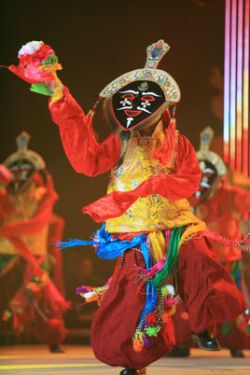Difference between revisions of "Tibetan Opera"
From Wiki China org cn
imported>Ciic |
imported>Ciic |
||
| Line 1: | Line 1: | ||
[[File:Tibetan opera.jpg|thumb|250px]] | [[File:Tibetan opera.jpg|thumb|250px]] | ||
| − | Based on Tibetan folk songs and dances, '''Tibetan Opera''' first appeared towards the end of the fourteenth century and developed into an influential ethnic opera in the seventeenth century. It is popular in Tibetan communities in [[Tibet]], [[Sichuan]], [[Qinghai]] and southern [[Gansu]]. The librettos mostly consist of folk ballads and the tunes are fixed. The singing is high-pitched and loud, the soloists are accompanied by a chorus. Some characters wear masks. Tibetan opera is usually performed in the open air. Its traditional repertoire includes full-length items based on folk and Buddhist stories, such as ''Princess Wencheng'' and ''Prince Norsang'', as well as small skits with singing and dancing. | + | Based on Tibetan folk songs and dances, '''Tibetan Opera''' ('''藏戏''') first appeared towards the end of the fourteenth century and developed into an influential ethnic opera in the seventeenth century. It is popular in Tibetan communities in [[Tibet]], [[Sichuan]], [[Qinghai]] and southern [[Gansu]]. The librettos mostly consist of folk ballads and the tunes are fixed. The singing is high-pitched and loud, the soloists are accompanied by a chorus. Some characters wear masks. Tibetan opera is usually performed in the open air. Its traditional repertoire includes full-length items based on folk and Buddhist stories, such as ''Princess Wencheng'' and ''Prince Norsang'', as well as small skits with singing and dancing. |
[[category:opera]] | [[category:opera]] | ||
[[category:art]] | [[category:art]] | ||
Latest revision as of 01:03, 3 August 2016
Based on Tibetan folk songs and dances, Tibetan Opera (藏戏) first appeared towards the end of the fourteenth century and developed into an influential ethnic opera in the seventeenth century. It is popular in Tibetan communities in Tibet, Sichuan, Qinghai and southern Gansu. The librettos mostly consist of folk ballads and the tunes are fixed. The singing is high-pitched and loud, the soloists are accompanied by a chorus. Some characters wear masks. Tibetan opera is usually performed in the open air. Its traditional repertoire includes full-length items based on folk and Buddhist stories, such as Princess Wencheng and Prince Norsang, as well as small skits with singing and dancing.
